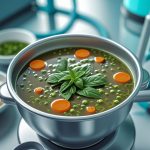Kidney health is often an overlooked aspect of overall wellbeing until issues arise. Our kidneys are remarkable organs, constantly filtering waste products from our blood, maintaining electrolyte balance, and regulating blood pressure. When kidney function declines – due to conditions like diabetes, high blood pressure, or simply the aging process – it’s crucial to support their work through lifestyle adjustments. One easily accessible and profoundly beneficial adjustment is dietary modification. Specifically, focusing on soups crafted with kidney-friendly ingredients can significantly reduce the burden on these vital organs. This isn’t about restrictive dieting; it’s about smart food choices that nourish your body while easing the workload of your kidneys.
Many individuals managing kidney health find themselves needing to limit certain nutrients like potassium, phosphorus, and sodium. Traditional diets often contain high levels of these minerals, making careful planning essential. Soup, however, offers a fantastic canvas for control. By selecting low-potassium vegetables, lean proteins, and minimizing salt intake, you can create delicious and nourishing soups that are gentle on your kidneys. This article will explore simple soup recipes and ingredient considerations designed to support kidney function, offering practical guidance for those looking to proactively manage their health through mindful eating. Remember, consulting with a registered dietitian or healthcare professional is always the best course of action for personalized dietary advice.
The Foundation: Kidney-Friendly Soup Principles
Creating soups that minimize kidney load isn’t about deprivation; it’s about intelligent substitution. Many flavorful and satisfying soups can be made while respecting your kidneys’ needs. The core principles revolve around managing three key nutrients: potassium, phosphorus, and sodium. Potassium is found in many fruits and vegetables but can accumulate to dangerous levels in individuals with impaired kidney function. Phosphorus, similarly, requires mindful management as the kidneys struggle to eliminate excess amounts. And sodium, of course, contributes to high blood pressure, a significant risk factor for kidney disease – so minimizing it is essential.
The beauty of soup lies in its versatility. You can easily swap out high-potassium vegetables like potatoes and spinach for lower-potassium options such as cauliflower, cabbage, or green beans. Lean protein sources—chicken breast, fish, or even tofu—provide necessary nutrients without overwhelming the kidneys with excess waste products from red meat. Broth is a crucial element; homemade broth allows you complete control over sodium content, while commercially available broths require careful label reading to select low-sodium varieties. Ultimately, the goal is to create flavorful and nourishing soups that support kidney health rather than compromise it. Consider incorporating these principles alongside suggestions from foods that support kidney filter function for a holistic approach.
Furthermore, consider the cooking method. Boiling vegetables can actually reduce potassium levels as some of the mineral leaches into the water. Discarding the boiling water after blanching or simmering helps minimize potassium intake. This simple technique can make a significant difference in managing nutrient levels within your soup. Don’t underestimate the power of herbs and spices! They’re excellent flavor enhancers that allow you to reduce sodium without sacrificing taste.
Building Blocks: Low-Potassium Vegetable Choices
Choosing the right vegetables is paramount when crafting kidney-friendly soups. While many delicious options are off-limits due to their high potassium content, there’s still a wide array of choices available to create flavorful and nutritious meals. Cabbage, cauliflower, green beans, onions, peppers (especially red and yellow), radishes, and zucchini are all excellent low-potassium options that can form the base of many soups.
It’s important to understand that potassium levels can vary slightly depending on growing conditions and preparation methods. However, focusing on these consistently lower-potassium choices provides a solid foundation for your soup recipes. Remember to always check reliable sources like the USDA FoodData Central database (fdc.nal.usda.gov) for precise nutrient information if you have specific concerns or dietary restrictions.
Another useful tip is to pair high-potassium vegetables with low-potassium ones in smaller quantities. This allows you to enjoy a broader range of flavors without significantly increasing your potassium intake. For instance, adding a small amount of carrots to a largely cabbage-based soup can enhance flavor while remaining within reasonable limits. Prioritizing variety and mindful portion control are key. These dietary adjustments work best when combined with an active lifestyle that supports kidney function.
Protein Power: Lean Choices for Kidney Support
Protein is essential for maintaining muscle mass and overall health, but the type and quantity you consume matter significantly when managing kidney disease. Red meat, while a source of protein, produces more waste products during digestion, placing extra stress on the kidneys. Therefore, lean protein sources are preferable. Chicken breast (skinless), fish (salmon, tuna, cod – in moderation due to phosphorus content), turkey breast, and even plant-based proteins like tofu or tempeh are all excellent choices for kidney-friendly soups.
When incorporating protein into your soup, it’s crucial to be mindful of portion sizes. Excessive protein intake can still strain the kidneys, so following recommended daily allowances based on individual needs is essential. A registered dietitian can provide personalized guidance on appropriate protein intake levels. Furthermore, consider how you prepare the protein. Grilling, baking, or poaching are preferable to frying, as they minimize added fats and unhealthy cooking methods.
Tofu, a versatile plant-based protein source, is particularly well-suited for kidney-friendly soups. It’s low in phosphorus and potassium and can absorb flavors beautifully, adding texture and substance without overwhelming the kidneys. Choosing lean proteins and managing portion sizes are vital steps towards supporting kidney health. Pairing this with meal prep adjustments that reduce internal pressure can further support overall wellbeing.
Flavor Without Sodium: Herbs, Spices & Broth
Sodium is a major concern for individuals with kidney disease, as it contributes to high blood pressure and fluid retention. The challenge lies in creating flavorful soups without relying on excessive salt. Fortunately, there are numerous ways to achieve this! Herbs and spices are your allies – experiment with garlic powder, onion powder, paprika, turmeric, thyme, rosemary, basil, and oregano to add depth and complexity to your soup without increasing sodium levels.
When using commercially prepared broth, always check the label for sodium content. Opt for low-sodium or no-sodium added varieties whenever possible. Even better, consider making your own broth from scratch! This allows you complete control over ingredients and sodium levels. Homemade vegetable broth is easy to make – simply simmer vegetable scraps (onion skins, carrot tops, celery ends) in water for several hours, then strain.
Another technique is to use lemon juice or vinegar to brighten the flavor of your soup. A splash of acidity can often replace the need for salt. Don’t be afraid to experiment with different combinations of herbs and spices to discover flavors you enjoy. Remember that taste buds adapt over time – reducing sodium intake gradually will make it easier to appreciate the natural flavors of your ingredients. These small changes, when combined with calm kitchen habits that reduce digestive pressure, can have a profound impact on overall health.
For even greater support, consider integrating these soup choices into a broader dietary plan like daily food patterns that reduce nighttime urge to minimize stress on your kidneys around the clock.
Finally, remember that hydration is key – and soups can contribute to this! Explore easy soups that double as gentle hydration tools for a refreshing and supportive addition to your diet.





















